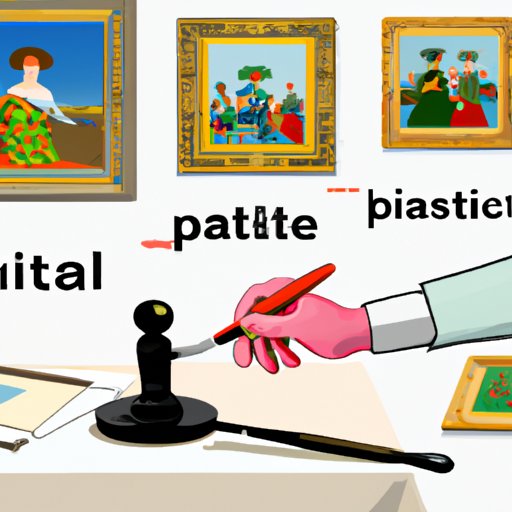Introduction
Finding the artist of a painting can be an exciting and rewarding challenge. Knowing who created a particular piece of artwork can add to its value and give it new context and meaning. But discovering the identity of the painter often requires patience and research. To help you on your quest, here is a step-by-step guide to finding the artist of a painting.
Examine the Signature on the Painting
The first place to look for clues about the artist of a painting is in the signature. If you are lucky, the painting will have a clearly visible signature that is easy to interpret. Look closely at the signature for any letters or symbols that could indicate the artist’s full name or initials. If the signature is illegible, try using a magnifying glass to get a better view.
If the signature contains only initial(s), you may need to do some research to identify the artist. Try looking up the initial(s) in an encyclopedia of art, a dictionary of artists, or an online search engine. You may also want to consult a professional appraiser or art historian if you are still unsure of the artist’s identity.
Research the Painting’s Provenance
Another way to identify the artist of a painting is to examine its provenance, or history. Provenance is the ownership history of an artwork, from the time it was created until the present day. It includes information about the artist, where the painting was exhibited, and who owned it in the past.
When researching provenance, there are many sources of information you can consult. Art museums and galleries often keep records of the works they own and exhibit. Auction houses also maintain detailed records of the artworks they sell. Newspapers and magazines may contain articles about the artist, and websites like the Getty Research Institute provide access to catalogs and other documents related to the artist and their work.

Consult an Expert in the Field
If you’re still having trouble identifying the artist of a painting, consider consulting an expert. Experts in the field of art include appraisers, curators, and art historians. They are knowledgeable about the artist, their style, and the techniques used in creating the painting. An expert can also offer advice on how to authenticate the painting.
Experts can be found online, in art galleries and museums, or in auction houses. You can also contact art associations and societies or ask your local library for referrals.

Use Online Databases to Search for Information about the Painting
Online databases are another valuable resource for researching the artist of a painting. Popular databases such as the Getty Provenance Index, the Art Loss Register, and eBay’s Art Market Report can provide information about the painting, including the artist’s name, the title of the painting, and the year it was created.
When searching online databases, it is important to use keywords that accurately describe the painting. Try to include the artist’s name, the title of the painting, and any other relevant information. You may also want to use more general terms such as “painting” and “artist” to broaden your search results.
Look for Any Identifying Marks, Labels, or Inscriptions on the Back of the Canvas
Some paintings may have identifying marks, labels, or inscriptions on the back of the canvas. These can include the artist’s name, the title of the painting, or the date it was created. Look closely at the back of the canvas to see if there are any markings that can help you identify the artist.
You may also want to look for labels or stamps from previous owners or galleries. These can provide clues to the painting’s provenance and help you trace the painting’s history.

Search for Similar Works by the Artist
Once you have identified the artist of a painting, you can begin to search for similar works. Start by looking for the artist’s name in online databases and galleries. You may also want to search for books or articles about the artist. These can provide insights into the artist’s life and work, as well as information about other works they have produced.
Comparing the painting you are researching to other works by the same artist can help you determine its authenticity and value. It can also give you a better understanding of the artist’s style and technique.
Check Auction House Records
Auction houses keep detailed records of the artworks they sell. These records can provide valuable information about the artist, including the estimated sale price, the size of the painting, and the location where it was sold. By comparing this information to the painting you are researching, you can gain a better understanding of the artist and the painting’s provenance.
When researching auction house records, it is important to check multiple sources. Popular auction houses include Christie’s, Sotheby’s, and Bonhams. You can also search online auction sites like eBay and Etsy for additional information.
Conclusion
Identifying the artist of a painting can be a challenging but rewarding process. By following these steps, you can gain a better understanding of the painting and the artist who created it. Start by examining the signature, then research the painting’s provenance. Consult an expert in the field, use online databases to search for information, and look for any identifying marks on the back of the canvas. Finally, search for similar works by the artist and check auction house records for additional insights.
With patience and dedication, you can uncover the identity of the artist behind a painting.
(Note: Is this article not meeting your expectations? Do you have knowledge or insights to share? Unlock new opportunities and expand your reach by joining our authors team. Click Registration to join us and share your expertise with our readers.)
